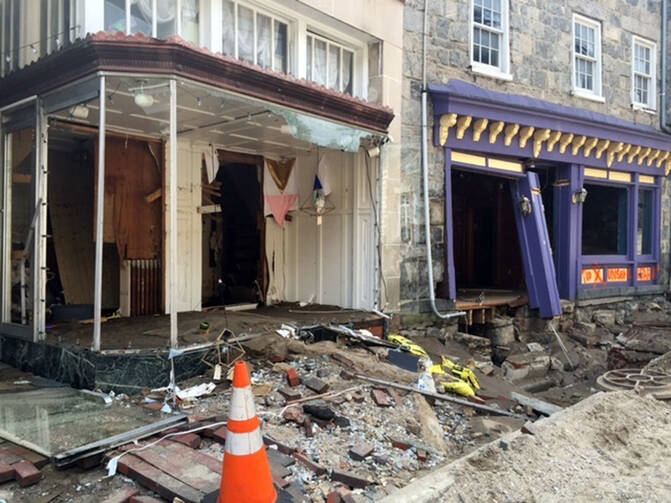When flash flooding turned the archaic metaphor "Head for the hills" into a literal imperative on July 30, some of those threatened by the rushing waters in Ellicott City found a Catholic church.
"Pretty much everyone was telling the same story," said Father Warren Tanghe, pastor of St. Paul, a historic church located at the top of the hill on St. Paul Street.
The church saw a deluge but not to the extent of the parallel and also steeply inclined Main Street, where most of the damage and mayhem—including two deaths—in the historic Maryland city occurred.
The stories, as related by Father Tanghe, were of a nice night out in a nice town, and a nice meal in a restaurant, with a view of rain falling at an increasingly remarkable clip.
A sudden "loud noise" was followed by water that rapidly rose to kneecap-level, and staff of several restaurants urging patrons out the back doors of their establishments, which fronted Main Street, while strongly urging them to seek high ground.
Father Tanghe received a phone call from a concerned parishioner between 8 and 8:30 p.m. "I didn't check the clock," he said.
The woman was worried for the attendees of a night meeting at the church, and was especially adamant that they not attempt to leave via Main Street.
"She was clearly upset and traumatized, as anyone would be if you started seeing cars floating by with people in them," Father Tanghe recalled in an interview with the Baltimore Archdiocese's Catholic Review.
When he hung up the phone, he started to notice people walking up St. Paul Street toward the church.
"Of course, they were [soaked]," he said, "because it was coming down like nobody's business."
Eventually, people were taking refuge in Dohony Hall, at the east end of the church campus, and in its Center for the New Evangelization, a newer building at the west end of campus.
"Father [Tanghe] came in and very pastorally said, 'The weather is bad, and you guys can stay here as long as you need, including overnight,'" said John Papania, business manager for St. Paul Parish. "He did everything he could from a pastoral point of view."
An effort is underway to assess fully the damage to downtown Ellicott City, which were catastrophic.
The dead were identified as Marylander Joseph Blevins, 38, of Windsor Mill and Jessica Watsula, 35, of Lebanon, Pennsylvania.
Ellicott City, about 12 miles west of Baltimore, is located the Patapsco River Valley. The river is a major waterway that flows into the Chesapeake Bay. The origins of the 19th-century mill town date to 1772; it has more than 200 18th- and 19th-century buildings.
On Aug. 1, Baltimore Archbishop William E. Lori, who had been in Krakow, Poland, for World Youth Day, directed his office to request that all parishes pray for the dead and those impacted by the flooding, according to archdiocesan spokesman Sean Caine.
Caine added that further information regarding assistance with relief efforts would be shared once officials determined specific needs.
Father Tanghe said that in the midst of the crisis, he received two communications from Krakow—a call from the archbishop and an email from Father Matthew Buening, a former pastor of St. Paul who now serves the Catholic youths of Towson University as chaplain of the school's Newman Center.
Those refuge-seekers at St. Paul—at least 50, according to Father Tanghe—eventually found their way home or out of Ellicott City proper, with the help of motorists arriving at the top of the hill to survey the scene.
Papania said that parish staff had an "impromptu" meeting on Aug. 1.
"We're looking for the most focused ways the parish can support the rebuilding, both financially as well as material support," he said.
Papania also is on the board of directors of the Ellicott City Partnership, a business association that began spearheading the recovery effort immediately after the flood. He said that 1,500 volunteers were ready to help July 31, the day after the disaster.
According to Father Tanghe, St. Paul Church sustained no damage. He was seeking out parishioners who may have been impacted by the flood.
"The community is obviously in shock," he said. "We've been hit and we've been hit hard."
He reported that Sunday Mass attendance the day after the flood was surprisingly high at about 50 percent.
"There were also faces that were not familiar to me in the congregation," he added.
It wasn't the first disaster faced by Father Tanghe.
A former Episcopal priest, he was chaplain of the local fire department on Long Island, New York, he said, when explosions tore through a fireworks factory in 1983, killing two and severely damaging homes.








